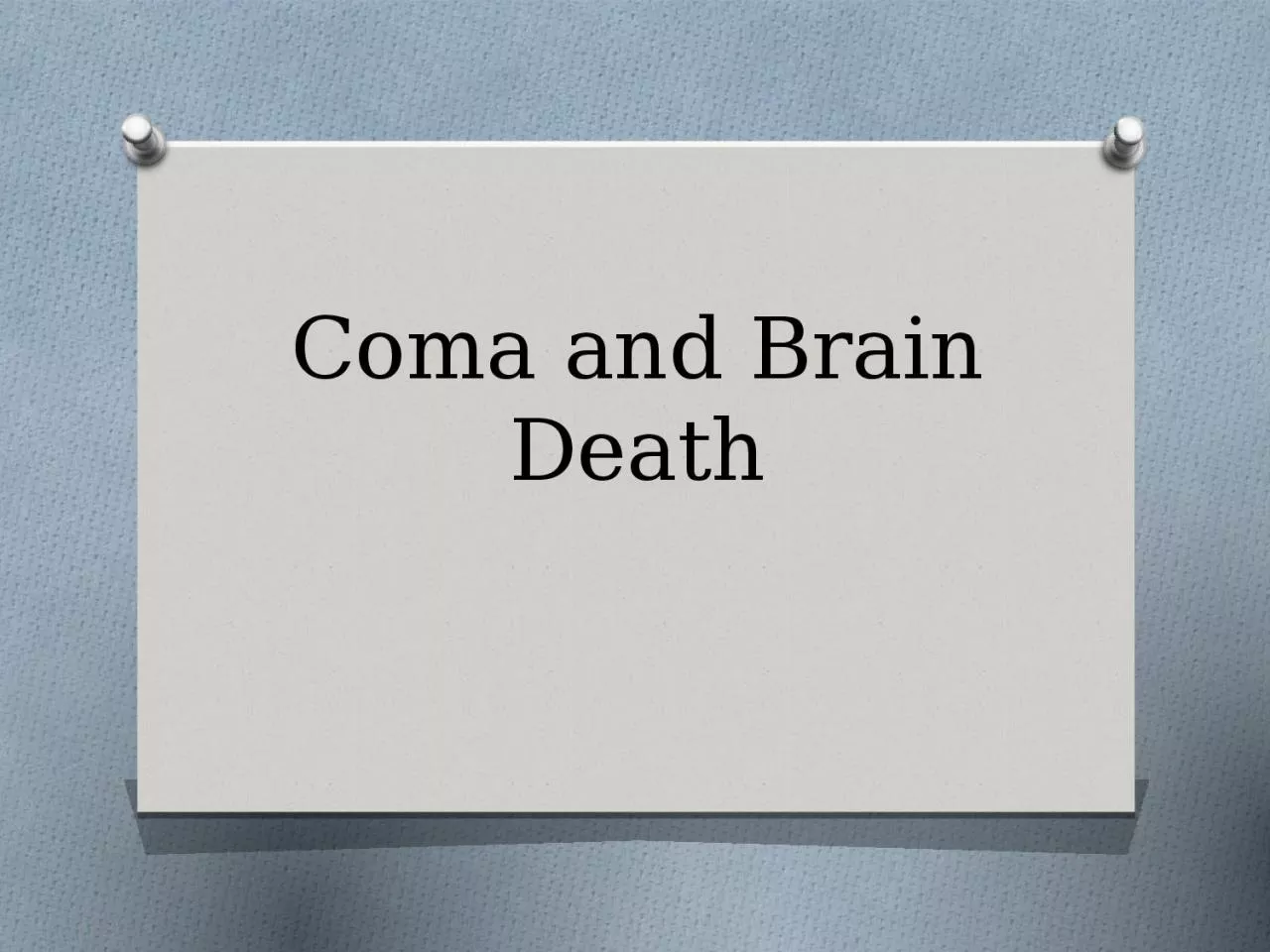

Define Coma and altered consciousness Understand the brain death exam Altered Level of Consciousness Coma unconscious state Does not respond to stimuli appropriately Eyes closed no purposeful motor response no language comprehension or expression ID: 1007579
Download Presentation The PPT/PDF document "Coma and Brain Death Objectives" is the property of its rightful owner. Permission is granted to download and print the materials on this web site for personal, non-commercial use only, and to display it on your personal computer provided you do not modify the materials and that you retain all copyright notices contained in the materials. By downloading content from our website, you accept the terms of this agreement.
1. Coma and Brain Death
2. ObjectivesDefine Coma and altered consciousnessUnderstand the brain death exam
3. Altered Level of ConsciousnessComa: unconscious stateDoes not respond to stimuli appropriatelyEyes closed, no purposeful motor response, no language comprehension or expressionVegetative State: Must meet all 3 criteriaNo purposeful voluntary responsesNo evidence of language comprehensionSleep/wake cycles are apparent – eyes open, unable to interact with environmentMinimally conscious state: 1 or moreCan follow simple commandsYes/no gestures even if not accurateVerbalizesAppropriate response to external stimuli: tracking, smiling, reaching for things
4. When can you determine brain death?Irreversible cause of comaRule out other reasons for unresponsivenessEnsure patient is:NormothermicNormotensive (even if on pressors)Has normal electrolytesNot on any drugs that could cause coma
5. Who can perform a brain death exam?Any 2 physicians, not from the same teamDifferent laws for different statesTexas requires 2 exams 6 hours apart
6. Texas Law: Definition of Death“(a) A person is dead when, according to ordinary standards of medical practice, there is irreversible cessation of the person's spontaneous respiratory and circulatory functions. (b) If artificial means of support preclude a determination that a person's spontaneous respiratory and circulatory functions have ceased, the person is dead when, in the announced opinion of a physician, according to ordinary standards of medical practice, there is irreversible cessation of all spontaneous brain function. Death occurs when the relevant functions cease. (c) Death must be pronounced before artificial means of supporting a person's respiratory and circulatory functions are terminated.”
7. Components of Brain Death ExamAssessment of cranial nerve brain stem functionAssessment of any level of responsivenessResponse to noxious stimulationApnea OR (if patient too unstable for apnea test) confirmatory testNuclear flow studyTCD’sEEGCerebral angiography
8. Steps of the brain death examPupils not reactive to light (CNII and III)Pupils usually between 4-9mm; pinpoint pupils not associated with brain deathNo corneal reflex (CNV and VII)Oculocephalic and oculovestibular reflex absent (CN III, VI, VIII)Oculocephalic = doll’s eyes. Cannot do if c-spine not clearedOculovestibular = no eye deviation. Use 50 ml cold water/saline and watch on each side for 1 minute
9. Steps of brain death examNo facial movement to noxious stim (CN V, VII)Noxious stim should be central pain (stim above nipples, TMJ, supraorbital)No cough or gag (CN IX and X)
10. What can confound your exam?Pupillary response can be altered by: eye trauma, scopolamine, atropineOculovestibular response can altered by: TM disruption, disease of inner ear, anticholinergic drugsCases of viper envenomations causing brain dead like state d/t coma and ophthalmoplegia
11. Apnea TestPre-oxygenate patientGet baseline ABG – try to normalize PCO2 as much as possible prior to apnea testPlace cut nasal cannula down ETT during testOne person needs to time the test – not the physicians performing testPressors can be titrated during testStop test if: SBP cannot be maintained >90 or sats <90%Goal: PCO2 >60mmHg or 20mmHg rise over pretest PCO2
12. Neurologic ExamApnea test:Prerequisites: normotensive, normothermia, eucapnia, normoxiaPatient should be preoxygenated for at least 10 minutesCheck PCO2 prior to testRemove patient from ventilator, supply O2 and watch for breathing for 8-10 minutesStop test if sats <85% or SBP <90Can use a t-piece with CPAPPCO2 >60 or 20mmHg above starting pointInconclusive tests can be repeated
13. Brain DeathAncillary Tests: EEG, angio, nuclear scan, TCD, CTA, MRANot necessaryUsed if apnea test unable to be doneIn lieu of repeat examDocumentation: time of deathTime when POC2 reached target levelTime when ancillary test results reportedTOSA required to be contacted once brain death confirmed
14. Can patients move when thy are brain dead?One study showed up to 55% of patients have movements when brain deadMovements such as:Spinal reflexes causing movement of limbs other then posturingSweating, flushingDTR’sBreathing-like movements